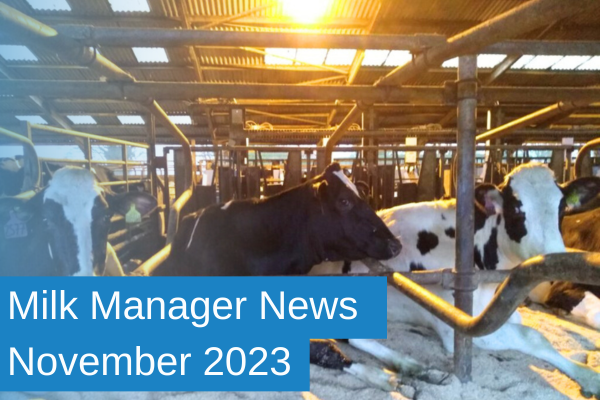MMN November 2023 – Optimal Lighting for Dairy Cows
10 November 2023With margins being tight, it is important to consider marginal gains and what can be done to improve your existing system. There is widespread consensus around the beneficial effects of optimising lighting in housing across all stock ages. Natural day length is insufficient for most of the housed period in Scottish systems, so to optimise light levels natural light must be supplemented with modern energy-efficient artificial light.
What is the optimal lighting level?
Lighting level is measured using light/lux meters and these are available to buy for between £30 to £150 online. These devices measure illuminance in the shed, giving a reading for the strength of the light shining on a surface, with a unit called a lux. The optimal lighting cycle varies depending on the age of the stock and what stage of the production cycle they are in.

What are the benefits of optimal lighting?
Implementing optimal lighting has multiple benefits for your herd including increased milk yields, enhanced growth rates in youngstock, higher feed intake, reduced stress, improved fertility and better cow movement through the shed. In addition, a well-lit shed also benefits you and your staff, making jobs in previously poorly lit areas easier and allowing staff to see cattle exhibiting bulling behaviour or ill cows easier.
Providing in excess of 150 lux at cow eye level for 16-18 hours a day has been shown by multiple studies to lift milk yields by around 7-8% with a 2-3 week lag in effect and a 7-9 week lag in feed intake increases.
How can I provide optimal lighting levels for my cattle?
Optimal lighting levels cannot be provided by natural light for the entire year in Scotland. As such, artificial lighting must be used to supplement natural light, although natural light should be utilised as much as possible to reduce energy costs.
Natural light can be increased by cleaning and maintaining skylights in existing sheds or installing new skylights. In addition, the sides of the shed could be altered to increase natural light in the shed, but this work should be undertaken with consideration for ventilation.
There are many different options available when considering artificial lighting. To provide adequate lux levels, lights chosen could be high-pressure sodium lights, metal halide lights or multiple fluorescent fittings. However, LED lighting is generally recommended as they are more efficient and also have benefits such as spectral output control and dimming capability.
The artificial lighting should be controlled by a timer, with light level sensing and a manual override. Different areas of the shed should have separate controls to enable staff to light certain areas as required during periods of darkness. Red lighting could also be incorporated into the system as this would allow staff to conduct night checks without disturbing the cattle during the period of darkness.
In addition to improving natural light and installing an artificial lighting system, the reflectivity of walls and roof material should be considered. Painting surfaces white or light-coloured is a cheap and easy way to increase light levels.
Cost vs benefit
Natural light can be improved at quite a low cost through maintenance and minor shed alterations. The implementation of a new controlled artificial lighting system varies in cost depending on the existing system and light levels. A case study conducted by AHDB found that the cost of replacing an old sodium lighting system with a new LED lighting system was £6,000, with energy savings giving the business a payback period of 8 years. However, when increased milk yields were factored in the payback period reduced to 6 weeks. This case study was conducted in 2021 and costs will have since increased, but it is still the case that the payback period will be far shorter than the lifespan of the artificial lighting system implemented.
Further information
BRP+ Better cattle housing design | AHDB
Dairy Lighting Technology Review | AHDB
James Orr, james.orr@sac.co.uk; 01292 525010
Sign up to the FAS newsletter
Receive updates on news, events and publications from Scotland’s Farm Advisory Service

